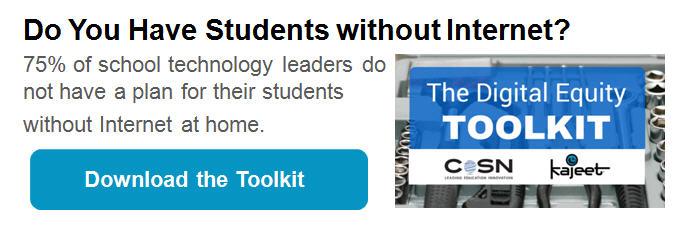How Much Data Does a Student Need?
Written by:
Kajeet
To close the Homework Gap, just how much data does a student need? This is not a simple question, but it is an important one that is addressed in the CoSN Digital Equity Toolkit.
The Data Usage Answer
Student usage on the Kajeet Education Broadband program averages 1.57 GB per student per month. This includes data from the tens of thousands of students across 41 states, and Washington, D.C., and over 375 school districts.
This number is dependent on the filters and digital curriculum program the school has in place, along with when and how much the Kajeet SmartSpot® devices are used.
Student Data Usage
During the school day, 78 percent of students use technology devices, according to eSchool News. Plus, 86 percent of schools anticipate an increase in spending on digital curriculum. Teachers continue to shift their focus to technology and online resources.
Digital learning is here to stay.
But with over three-quarters of students using tech inside the classroom, how much do students use tech once they leave school?
According to a Speak Up Research Project for Digital Learning survey, there are discrepancies between teachers’ expectations, and their students’ reality. The report states, “Few teachers say they regularly assign Internet-dependent homework, more principals think Internet-dependent homework is being assigned, but students say they regularly use the Internet to help with homework.” Whether or not teachers are assigning homework that directly depends on the Internet, students are using the Internet as a tool to help complete assignments.
While educators know how often students use digital resources inside their classroom, they are not fully aware of use outside of school. As technology use increases in the classroom, educators should expect that trend to be reflected once students leave school grounds.
An Increase in Student Data Use Outside of School
A 2015 Ericsson report found that 61 percent of commercial mobile app traffic is from Facebook, YouTube, Netflix, Instagram, and Snapchat.”
That traffic is expected to increase by 38 percent annually between 2017 and 2022, according to the latest Ericsson mobility report. Unlimited access to these social media sites will likely bust anyone’s budget, even on a 5 GB plan.
However, the biggest growth will be video traffic, expected to grow 50 percent annually over the next six years. Unlimited access to video will eat up even more data than any other traffic.
The Digital Equity Toolkit states:
Some districts recommend blocking consumer video services like YouTube but allowing education video services (e.g. TeacherTube, SchoolTube, YouTube for Schools, Khan Academy, TedEd, PBS LearningMedia, etc.).
According to Michael Flood, Vice President for Strategy at Kajeet, “Even with consistent ‘acceptable use’ policies, the practices of the educator/student can vary data usage – are they in a Virtual Learning program that relies heavily on video conferencing? Are they online all the time (such as a virtual or hospitalized student), or only for ‘homework hours’ in the afternoon, evening, and/or weekend? A student’s device type also influences usage as different platforms push out OS/App updates with different frequencies.”
Once students are outside of school buildings and no longer on the school’s network, it can be difficult to manage their access. Kajeet provides a robust filtering service with the Sentinel® cloud portal, which categorizes and analyzes millions of new URLs every day. Filter the websites that your students can, or cannot use, and help keep data costs down through this limited access.
Off-Campus Internet Access
The below is an excerpt from the CoSN Digital Equity Toolkit.
For example, districts that switched from environments whose design isn’t tailored for off-campus student behaviors have seen as much as a 3x-5x reduction in average data usage, primarily from the careful management of consumer entertainment uses.
PROS:
- Students have Internet access wherever they go.
- Particularly relevant for students spending time in multiple households or frequently moving.
- With school-provided access, educators can gain visibility into student activity that can inform improved academic strategies or evaluate the use of instructional resources.
CONS:
- Amount of data available per student varies depending on school-provider arrangements. Students may encounter data limitation challenges.
- Allowable hotspot use may be limited to student use for homework, thus not a viable approach to advancing household-wide digital equity.
- Up front and ongoing cost for schools.
Connect with Kajeet
If your school is 1:1, or you have begun incorporating digital tools into your lesson plans or homework assignments, it’s important to ensure every child has equal access to the Internet. We can work together to determine the best data plan for your school or district, and continue to close the Homework Gap.
This blog post was originally posted on March 9, 2016 and has been updated.


